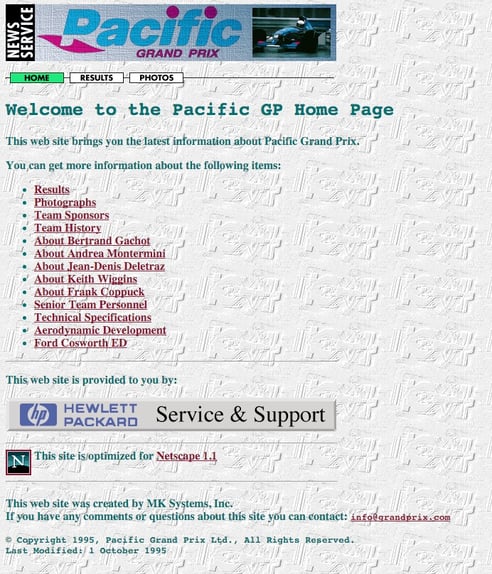On a long enough timeline, everything falls apart. It’s just a question of how long it takes. This is especially true about web-based business presences since digital spaces are so volatile. Algorithms change, content discovery patterns evolve, and new tools and platforms get hot seemingly out of thin air.
How Fast Will My New Website Go Obsolete?
You might be doing substantial business for several years in a row, attracting relevant audience members with your published website content and offsite digital distribution tactics, capturing leads, nurturing them and closing a steady flow of sales to keep your company thriving, only to see the pipeline suddenly dry up. What happened? Did flat design finally become so ubiquitous that your website’s skeuomorphic look (groan – that’s so 2006) stopped resonating with visitors?

More common than an abrupt dropoff, though, is the slow decay of a website’s business utility. Many business leaders find themselves facing complex cost-benefit calculations, wondering where that tipping point might be to justify scrapping an old site to invest in a full-on overhaul.
When You Really Should Redesign
So what’s an inbound marketing-dependent company to do? Is there a website shelf life formula? How can we decide when it does and doesn’t make sense to redesign and reboot? Isn’t there any way that we can tackle a redesign incrementally over time, to avoid this endless hamster wheel of obsolescence?
The most effective indicator of website obsolescence is a significant dropoff in its ability to drive business. You may think that you need to upgrade to a slick, hipster look – and maybe you do – but only if your funnel performance metrics are indicating that the site is failing to attract the quantity and quality of prospects that you seek.
Investing in a reboot can be highly valuable, but it’s important to take on such an initiative only if you can determine that it’s necessary and likely to be effective. If you are doing astonishingly well with your current site, then by all means, stick with the good thing! If, however, you see either a drop-off or have identified untapped opportunities for improvement, consider taking your site in a new direction.
Too Many Lost Opportunities
You may be patting yourself on the back if your site successfully captures 7% of its visitors as leads for later nurturing, but what about the 93% who don’t opt in? Who are they, how did they end up on your site, and why didn’t they convert? This is the type of evaluation that you’ll need to do because it’s this line of logic that will make or break the effectiveness of your redesign cost-benefit analysis. If you find that you are losing more in potential leads who do not convert than it would cost to redesign, then for sure – go on and take the plunge.
Of course, the idea of setting up a whole new site can be daunting, and for good reason, Creating a website from scratch is a major project, especially if it feels like you just went through the same process. And then the costs of reinventing the wheel can feel unseemly too. By the time you’ve completed your redesign, with all of its bells and whistles, it might well be time for another new one – or at least a facelift.
The decision gets a lot more nuanced, though, when we stop looking at redesign projects as being enormous undertakings and instead think of them as iterative works in progress. This is the key advantage of “growth driven design” (GDD) methodology, which allows companies to test continuously, refresh and improve web properties.
Instead of working with full-on overhauls every few years at the most, GDD emphasizes methodological experimentation and incremental rollouts for enhanced user experience, superior funnel transparency, and optimized business performance.
How Growth Driven Design Breaks the Cycle
GDD means that your website design is always being worked on and improved, so that it will never become obsolete again. Recognizing that your business and its business needs are perpetually evolving, GDD allows you to use that flux to your advantage, by focusing on different sections and aspects of your site as they need improvement, in an incremental process.
Growth driven design’s processes allow you to improve site performance in the areas where the opportunities are the greatest. Moreover, by breaking your site down into logical units and updating one aspect at a time, as identified by your analyses, you can amp up on what’s working well and make improvements to what isn’t.
Opting for GDD protects your company from falling prey to the whims of website trend volatility. That is, by limiting the scope of your mini-renovations, you can test the waters cautiously, always determining performance fit. Only once you see that it does do you commit to bringing the whole site up to the new standards, as it were.
GDD also helps you conquer the larger question of when you should redesign your site. Because you are continually redesigning some pieces of it, you don’t need to ask the same questions about whether it’s worth it. Instead of always wondering whether or not a complete reboot might pay for itself in future business, you can incorporate ongoing design improvements into your current conversion optimization efforts.
No Lead Left Behind
If you’re wondering whether it’s time to revamp your website, we recommend that you seriously consider growth driven design. By making your updates and enhancements part of your company’s ongoing inbound marketing and website management work, you can keep your web design expenditures reasonable and derive the most business impact possible from these efforts.
With GDD, your pace of change will never need to break into frantic response mode, instead undergoing agile, steady improvement.
A content and social media marketing specialist, Ben Jacobson joined the Lean Labs team in the summer of 2014. Ben has been active as a digital branding professional since the early days of social media, having overseen projects for brands including MTV, National Geographic, Zagat and Wix. His writing has appeared in Social Media Explorer, Search Engine Journal, Techwyse and the Mad Mimi Blog. Ben resides just south of the Carmel Mountain ridge in Israel with his dashing wife and two sprightly descendants.





